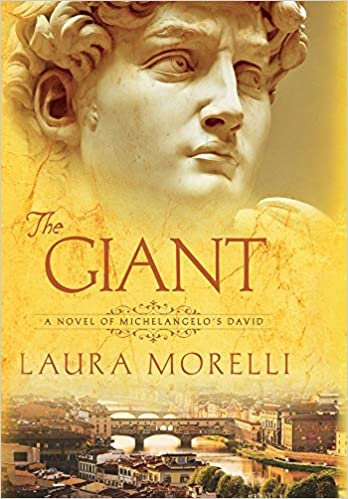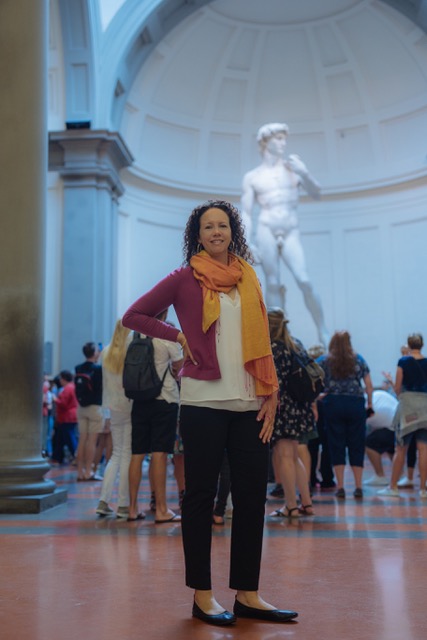Tag: laura morelli
Interview with Laura Morelli, Author of THE GIANT
If you’ve been to Florence you’ve seen Michelangelo’s David. If you haven’t been to Florence you’ve seen countless images of him. The David is a cultural icon and even 500 years after his creation still has the power to leave us awe struck.

Now Laura Morelli—talented novelist and PhD Art Historian—has a breathtaking new novel out about the creation of this Renassaisance Art Masterwork, and I am THRILLED to welcome her to my blog today to talk about the process of creation for both her novel, THE GIANT, and Michelangelo’s David!
Let’s start things off with a teaser for THE GIANT . . . .
As a colossal statue takes shape in Renaissance Florence, the lives of a master sculptor and a struggling painter become stunningly intertwined.
Florence, 1500. Fresco painter Jacopo Torni longs to make his mark in the world. But while his peers enjoy prestigious commissions, his meager painting jobs are all earmarked to pay down gambling debts.
When Jacopo hears of a competition to create Florence’s greatest sculpture, he pins all his hopes on a collaboration with his boyhood companion, Michelangelo Buonarroti. But will the frustrated artist ever emerge from the shadow of his singularly gifted friend?
From the author of THE PAINTER’S APPRENTICE and THE GONDOLA MAKER comes a gorgeously crafted, immersive tale of Renaissance Italy.
Laura, I have such distinct memories of the first time I stood in front of Michelangelo’s David—gape-mouthed and totally in awe. What do you think draws people to the David?
Me too! I am always amazed at the number of people who tell me that this sculpture is the thing that impressed them the most on a trip to Italy.
In fact, when my family returned from Italy last summer, I asked my four teenagers to name the top three favorite things they saw. The David was on the top of each of their lists (and I promise I tried not to influence their choices!). I think that’s amazing.

A Time Magazine article in the 1980s reported on the “emotional trauma” experienced by first-time viewers of the David. And a few visitors have even tried to disrobe before the statue, only to be quickly led away by museum guards!
I have long wondered what it was about this statue and the irreverent stone carver who made it that still has the power to capture people’s imagination–to make their jaws drop, to leave them speechless–even in our current time of multimedia overload. And even after studying it for some thirty years, I’m still not convinced it’s something that can be put 100% into words. That’s the power of art!
As a PhD art historian, how do you think the David influenced the course and direction of art at the moment of its unveiling and in the aftermath of its creation?
The David was the first colossal nude on Italian soil since ancient Roman times. Think about that… For a thousand years, no one had seen a nude male sculpture of this scale. But this David is actually a biblical hero in the guise of an ancient god, at the same time that he appears as a god in the image of a perfect man. He is both an Adam and a Hercules, both a Christian and a civic / political symbol. In short, the David seems to telescope all the aspirations and the ideals of the High Renaissance in a single work of art. I don’t think any sculptor who worked in Europe after 1504 could ignore it. Later works, like those of Gianlorenzo Bernini, would have been unimaginable without Michelangelo’s precedent.
Sometimes truth really is stranger than fiction. Can you share a fact or scene from The Giant which actually happened (or existed), but seems too strange to be true?
We have an amazing contemporary account of the sculpture leaving the cathedral workyard, where Michelangelo had been working on it for four years. At midnight on May 4, 1504, laborers broke the stone lintel above the gate of the workyard and began to move the sculpture slowly toward the Piazza della Signoria. They suspended the sculpture from a contraption made of ropes and pulleys, as well as greased logs to roll it forward. It took several days to reach its intended location. During that time, some boys were arrested for throwing stones at it; one of them turned out to be a relative of Lisa Gherardini—yes, the Mona Lisa (whose portrait Leonardo da Vinci was painting at the time, just a few streets away). You can’t make this stuff up!
Of course Michelangelo is not the only artist in The Giant . . . can you tell us a little bit about Jacopo Torni (or the artist he is based upon) and why you felt his story needed to be told?
As I looked for the right person to tell the story of Michelangelo’s gigante, I came across historical references to a Florentine fresco painter called Jacopo Torni, also known as L’Indaco.
The sixteenth-century art historian Giorgio Vasari tells us that L’Indaco lived “in close intimacy” with Michelangelo, and that Michelangelo found L’Indaco the funniest and most entertaining of his friends. We also know that Michelangelo invited L’Indaco to work with him on the Sistine Chapel in 1508. According to some sources, it was a friend who convinced Michelangelo to return to Florence to take on the David commission in 1501, and I like to think it was L’Indaco.
Michelangelo is one of the most notoriously temperamental artists in history, and I wondered about this relationship of seeming opposites. It is this push and pull of two creative friends, in combination with the creation of two of the most seminal works of art history—the David and the Sistine Chapel ceiling—that drew me to this story and made me want to explore this complicated friendship further.
Finally, I’d like to close out things with a Rapid Fire round:
- Favorite Italian dish: Risotto alla milanese, without a doubt!
- Character you’d love to write about but probably never will: A living artist.
- Why won’t you? It would be so tricky, I think, to write fiction or nonfiction about a real person who is either living or recently deceased.
- A piece of art that is special to you other than the David: I saw the cathedral of Notre Dame in Paris when I was 12 years old, and it was a “coup de foudre.” It led me to want to pursue art history and it’s still such a special building to me.
- Do you write to music or in silence? I love peace and quiet when I write.

Thanks so much to Laura for stopping by! Don’t forget to pick up your copy of THE GIANT readers—at Amazon, Indiebound, on Bookshop.org to support Independent booksellers, or your favorite local bookstore!